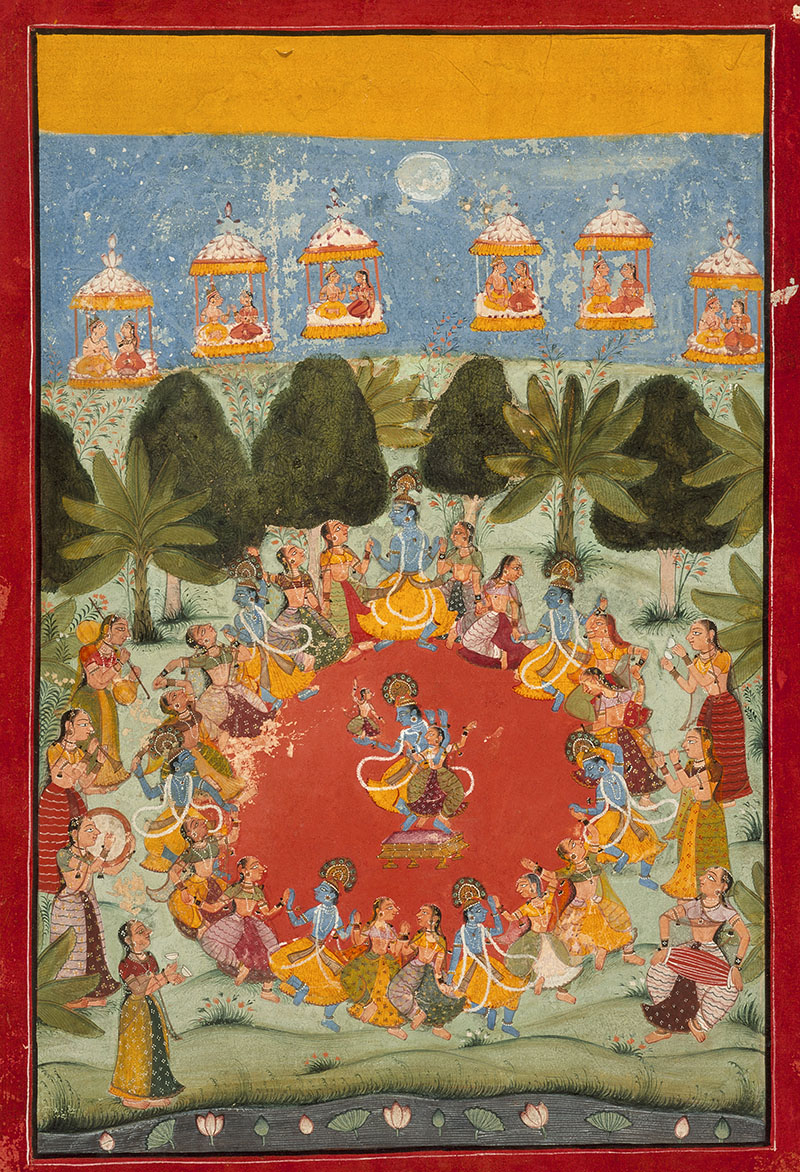A theme in Rajasthani manuscript painting, rasa lila celebrates the life of Krishna, the eighth avatar of the Hindu god Vishnu. It focuses on the deeds of Krishna as well as the unconditional love that Radha and the gopis of Vrindavan have for him, which serves as an allegory for the devotion of an individual towards a deity. This idea of spiritual love is most strongly symbolised in the depiction of the rasamandala, the sacred circular dance of Krishna and the gopis.
Historically, the Bhagavata Purana has been the primary textual source for the rasa lila. The tenth book of the Purana, the Dasamaskanda, narrates the life of Krishna. The story of the rasamandala, detailing the intense emotions of the gopis towards Krishna, is the central theme of five of its chapters, collectively known as the Rasa Panchadhyayi. Several other works of devotional poetry also focus on the theme of Krishna bhakti, particularly the Gitagovinda – a twelfth-century work of verse composed by Jayadeva – and the Sur Sagar, attributed to the sixteenth-century poet Surdas. Other texts that were commissioned to be manuscripts with accompanying paintings of Krishna include the Rasamanjari and the Rasikpriya.
Historically, Rajasthani manuscript painting visually depicted the rasa lila and rasamandala themes in various ways. A Rasikapriya series painted by the master artist Sahibdin in Mewar, for example, presented Krishna in the manner of a courtly figure. In some of the Kishangarh paintings – predominantly those painted by the artist Nihal Chand – Radha, Krishna and the gopis are also depicted in courtly settings. These paintings are further characterised by their unique visual idiom, including a distinct facial type whose use is limited to Krishna, Radha and a few gopis. In several ragamala sets, Krishna is depicted as the hindol and megha ragas, supplanting Madana as the central male figure in these paintings. Another recurring depiction is of Krishna as vasanta raga. In the Barahmasa series from the regions of Bundi and Kota, Krishna is the central figure, while in works from Jaipur and Alwar he features less prominently.
The themes of these paintings, as well as the royal patronage for depictions of Krishna, also underscore the strong cultural influence of Vaishnavism and the medieval era Bhakti movement in the region of present-day Rajasthan. The Kishangarh Rathors, for instance, were adherents of the Pushtimarga philosophy, in which Krishna is a central deity. The seventeenth-century ruler Raj Singh offered patronage to the Nathdwara temple, which became an important pilgrimage centre. Here, the Nathdwara school of devotional painting, with the art made primarily on cloth as pichhwai, emerged in the eighteenth century and featured a blend of Rajput styles. The eighteenth-century ruler of Jaipur, Pratap Singh, was also a poet and Krishna devotee, and his reign was marked by the production of several devotional manuscripts. Further, the depictions of Krishna in paintings of the Rajasthani school were not limited themes of devotional love. Illustrated series of the Bhagavata Purana also depict the miraculous deeds of Krishna, such as the vanquishing of demons and the lifting of Mount Govardhana.
Finally, rasa lila is also the name of a traditional performing art, in which troupes of actors and singers, called ras mandalis or raslila mandalis, enact stories from the life of Krishna. Located in Mathura and Vrindavan – places that are deeply tied to the life of Krishna – these troupes have travelled and performed throughout north India for centuries. The aesthetics of their performances, including elements of colour, costume and choreography, are also speculated to have had an influence on the depictions of Krishna and his life in Rajasthani manuscript painting.







